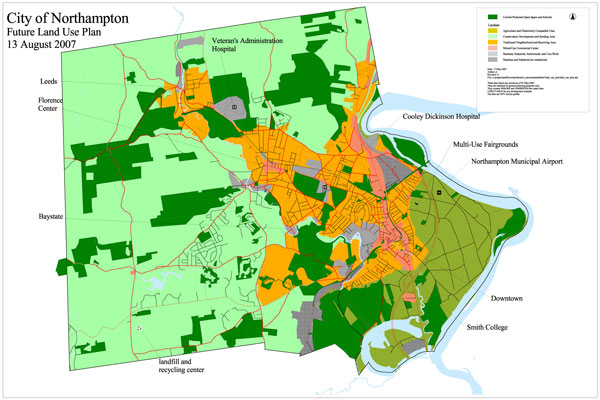
Here is the associated press release:
City of Northampton Zoning Revisions Committee
For immediate Release: January 21, 2010
Contact:
Joel Russell, Chair, Zoning Revisions Committee, jo******@***il.com, 413-584-7228
Danielle Kahn, Vice-Chair, Zoning Revisions Committee, dj********@***oo.com, 413-320-7208
Carolyn Misch, Northampton Office of Planning and Development, cm****@***********ma.gov, 413-587-1287
The future of King Street, appropriate forms of infill development, controlling sprawl, providing a range of housing options, and improving urban design in Northampton will be among the issues discussed in a citywide public forum on February 24, 2010 from 7-9 PM at the JFK Middle School Community Room. The forum, hosted by the Zoning Revisions Committee (ZRC), will give citizens of Northampton the opportunity to suggest how Northampton’s Zoning Ordinance might be changed to implement the City’s Sustainability Plan. After a brief presentation on the ZRC’s ongoing process and the key issues it faces in revising the zoning, the ZRC will hear from citizens on such issues as ensuring quality urban infill, maintaining neighborhood character, and protecting the City’s green spaces and environmental resources. The goal is to implement the Sustainable Northampton Plan in a manner that improves our quality of life and maintains the best features of our community. Members of the ZRC, which was appointed by the Planning Board as an advisory committee, include Joel Russell, Chair, Dennis Bidwell, Stephen Gilson, Danielle Kahn, Adin Maynard, Peter McLean, Jim Nash, Dillon Sussman, and Tom Weiner.
See also:
Joel Russell’s Introduction to Form-Based Zoning, as Presented to the Northampton Design Forum, 1/26/10 (PDF, 10MB)
Download Envisioning Sustainable Northampton – Final Notre Dame Studio Presentation Book
Envisioning Sustainable Northampton: Notre Dame Urban Design Presentation – Video and Handout
Video and Slides: Final Presentation of Design Northampton Week
Northampton Media: “Northampton’s Built Environment: Squandered Public Equity” by Tris Metcalfe, AIA (11/2/09)
Video Highlights from the 10/19/09 Mayoral Debate: Wetlands, King Street, Infill and the BID
March 10: Zoning Revisions Committee to Meet; Our Suggestions
The Zoning Revisions Committee is charged with recommending zoning changes that implement the Sustainable Northampton Plan. We urge the committee to keep these considerations in mind:
- Before trying to facilitate infill development, might it be best to first establish infill design standards? (see Springfield)
- How can we encourage development within already paved-over spaces as opposed to eating into greenspace? Why are spaces in certain in-town areas like King Street languishing unused? Are there concerns about hazardous waste that need to be addressed?
- How will proposed rule changes affect the quality of life within in-town districts? Changes that erode amenities (e.g. greenspace), raise safety issues (e.g. more flooding) or create hassles (e.g. more traffic jams) may defeat the purpose of the Sustainable Northampton Plan by motivating homebuyers to sprawl out elsewhere.
- Will the proposed rule changes encourage development that is in harmony with the surrounding neighborhood?
- How will proposed rule changes affect tree canopy ward by ward?
- How will proposed rule changes affect the percentage of impervious surface ward by ward?
- How will proposed rule changes affect the value of neighboring properties?
- How will proposed rule changes affect property taxes? (if you can build more units on a parcel, its taxable value might increase)
- Will the proposed rule changes alter the balance between single-family and multi-family housing units? (this could impact the municipal budget)
- Will the proposed rule changes discourage the possibly desirable development of new neighborhood centers in outlying areas? (e.g. through requiring high traffic mitigation payments for certain businesses)
- Will the proposed rule changes result in a ‘privatization’ of greenspace? This can happen, for example, with developments that sequester most of their greenspace behind buildings and away from the street.
Video: Zoning Revisions Committee, 10/28/09; Attract People to Infill Areas with Amenities
…we suggest the following to ease the way politically and safeguard the “receiving areas” (see map below):
- Give people positive reasons to live and work in the receiving areas (beyond any environmental or aesthetic benefits of curtailing sprawl). These might include:
- Access to next-generation Internet service
- Free wifi for homes, businesses and the public
- Robust tree-planting program (see benefits)
- Frequent clean-up of graffiti and trash (see ‘broken windows’ theory)
- Free snow-clearing from sidewalks
- Snow-clearing from bike trails
- Access to next-generation Internet service
- Prioritize the enactment of infill design guidelines
- Prevent awkward, inappropriate, overlarge infill developments
- Preserve urban greenspace
- Avoid increasing density to levels that lead to traffic jams and parking shortages
- Restrict the spread of impervious surface to reduce flooding risks and the urban heat-island effect
- Prevent awkward, inappropriate, overlarge infill developments
Proposed Future Land Use Map (PDF)
The orange zones are “Traditional Neighborhood and Receiving Areas”. The light green zones are “Conservation Development and Sending Areas”.
